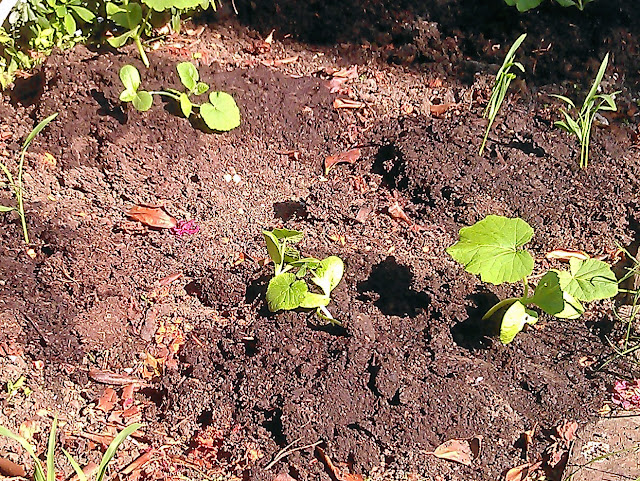You can grow certain plants in close proximity to each other for various reasons:
- Some plants will ward off pests, either by their smell, or secretions from their roots, or simply because they have sharp thorns. You can grow these plants close to those that are vulnerable from such pests in order to give them protection.
- Conversely you might use plants that are particularly susceptible to a pest as a ‘decoy’, to draw them away from another more valuable or delicate plant.
- Some plants will attract beneficial insects, such as lacewings, hoverflies or ladybirds, to the garden. Place these close to plants which need pollinators to set fruit.
- Some plants, notably legumes (peas and beans), will enrich the soil for other plants.
- Tall sturdy plants can be used to provide support for other plants, such as climbers.
- Trailing plants might act as ground cover, suppressing weeds and acting as a mulch, reducing water evaporation from the soil surface.
Three London Sisters
 |
| Squash seedlings after planting |
Start squash off in small pots, either indoors or in a greenhouse. Sow two seeds to a pot and keep the pots covered until they germinate, which should only take 5-7 days. Snip out the weaker seedling before transplanting.
Planting out
 |
| Plant corn in blocks to help ensure pollination |
Each circle above represents one 45cm diameter mound. The corn and bean plants will grow together on a mound; alternate mounds are left to squash which will need more space.
In the mounds shown here as yellow circles, plant four corn seedlings in a square shape. There should be at least 15cm between the plants. Then, plant four bean seeds, one between each corn seedling – you should be able to simply push the bean seed into the ground with your thumb or forefinger. Close the soil above it and firm the surface.
In the mounds shown here as orange circles, plant two squash, as far apart as possible on the mound.
Water all the seedlings well.
The beans should germinate within two weeks, by which time the corn should be about 30cm high. As the beans grow, they may need to be tied in initially to encourage them to grow up and around the corn. The squash plants may take a while to get going, but will grow rapidly when they do. They will need training to keep them to the Three Sisters growing area.
When squash fruit begin to form, place a clean tile underneath the fruit for them to rest on to protect it from the dirt and creepy-crawlies. Once a single plant has produced three fruit, stop the growing tip – this will help the plant concentrate on growing really good-sized fruit.
Depending on the variety, the sweetcorn should be ready to harvest from late August or September. Borlotti beans and squash can be left to mature on the plant. Make sure you lift them before the first frost.
Insect repellents
Carrots and onions make excellent companions in the vegetable bed. Many gardeners find that they need to protect the carrot crop from carrot fly, a dull-looking brown fly which flies low to the ground and can detect the smell of carrots from half a mile away. The female will lay her eggs in the soil close to the carrot roots, and when the larvae hatch, they start to feed on the growing carrots in the ground. When you dig up the crop, you’ll find tell-tale brown streaks and tunnels boring into the carrot itself.
 |
| Grow garlic or onions around the edge of beds to repel aphids. |
However, you can protect your carrots to a certain extent by sowing them in-between alliums (garlic and onions, mainly, although you could try leeks as well for a late-growing carrot crop – leeks don’t really get going until late summer). The smell of the onions is said to mask the scent of the carrots, so that the fly doesn’t realise the carrots are there.
In return, the carrots are said to mask the allium scent for the onion fly, which preys on onions and also garlic and shallots.
Garlic and onions are good for repelling many different insects, including aphids. The sulphur accumulated in their roots may also act as a natural pesticide. Some people plant alliums all around the edge of their plot or patch for this reason. Of course, you need to be sure that you don’t have any of these pests inside the plot already or else you will trap them in instead of keeping them out.
The magic of marigolds
 Marigolds are well-known for their insect repelling properties. They are especially associated with brassicas: plant marigolds around your cabbage and cauliflowers to ward off the whitefly. Furthermore, the roots exude a substance which are toxic to nematodes, including those which attack tomatoes. So plant marigolds around the tomatoes as well.
Marigolds are well-known for their insect repelling properties. They are especially associated with brassicas: plant marigolds around your cabbage and cauliflowers to ward off the whitefly. Furthermore, the roots exude a substance which are toxic to nematodes, including those which attack tomatoes. So plant marigolds around the tomatoes as well. Insect attractants
We think of bees as being the main pollinators of plants, but hoverflies also feed on nectar and are excellent pollinators. Plants which need a pollinator, such as squash and courgettes, and fruit trees will benefit.
Hoverflies are doubly welcome in the garden because their larvae will chomp their way through massive numbers of aphids. Ladybird and lacewing larvae are also enthusiastic consumers of aphids – a very good reason to attract them to the garden.
The beauty of companion planting
Useful links
For more about companion plants and specific plants which work well together, there is plenty of information on the following sites:
Golden Harvest Organics – plant lists and benefits of growing together.
Victoriana Nursery Gardens – the Three Sisters – growing the Three Sisters in the UK climate. We followed many of the suggestions here for the Secret Garden Club’s Three Sisters plot.
Renee’s Garden – US site with the story behind the Three Sisters tradition, plus Three Sisters planting diagrams.
National Vegetable Society – Good overview of companion planting principles plus plant lists.
Laura’s Organics – page on attracting beneficial insects to the garden.
 |
| Happy guests at the Secret Garden Club |
To find out about the Native Indian inspired food that MsMarmite served go here.






Wow its a very good post. The information provided by you is really very good and helpful for me. Keep sharing good information..
Garden Centre Castel Guernsey
Thanks for all your great tips. More power to your blog!
Thank you for this. Great post! I’m going to try the three sisters approach next year and I like the idea of planting kale inside my bean/pea teepees. It might just keep the pigeons away from them!